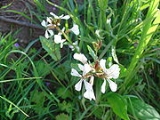
Eruca
Encyclopedia
Eruca is a genus of flowering plant
s in the family Brassicaceae
, native to the Mediterranean region.
The number of species is disputed, with some authorities only accepting a single species, while others accept up to five species. The following species are accepted by the Med-Checklist:
When treated as a monospecific genus, all are included within E. vesicaria.
They are annual plant
s growing to 20–100 cm tall. The leaves
are deeply pinnately lobed with four to ten small lateral lobes and a large terminal lobe. The flower
s are 2–4 cm diameter, arranged in a corymb, with the typical Brassicaceae
flower structure; the petals are creamy white with purple veins, and the stamens yellow. The fruit
is a siliqua (pod) 12–25 mm long with an apical beak, and containing several seed
s.
Flowering plant
The flowering plants , also known as Angiospermae or Magnoliophyta, are the most diverse group of land plants. Angiosperms are seed-producing plants like the gymnosperms and can be distinguished from the gymnosperms by a series of synapomorphies...
s in the family Brassicaceae
Brassicaceae
Brassicaceae, a medium sized and economically important family of flowering plants , are informally known as the mustards, mustard flowers, the crucifers or the cabbage family....
, native to the Mediterranean region.
The number of species is disputed, with some authorities only accepting a single species, while others accept up to five species. The following species are accepted by the Med-Checklist:
- Eruca loncholoma (Pomel) O.E.Schulz
- Eruca pinnatifida (Desf.) Pomel (syn. E. sativa subsp. pinnatifida (Desf.) Batt.; E. vesicaria subsp. pinnatifida (Desf.) Emberger & Maire)
- Eruca sativa Mill. (syn. E. vesicaria subsp. sativa (Mill.) Thell.)
- Eruca setulosa Boiss. & Reuter
- Eruca vesicariaEruca vesicariaEruca vesicaria is a species of Eruca native to the western Mediterranean region, in Morocco, Algeria, and Spain. It is closely related to Eruca sativa; that species is included in E. vesicaria by some botanists either as a subspecies E. vesicaria subsp. sativa or not distinguished at all; E...
(L.) Cav.
When treated as a monospecific genus, all are included within E. vesicaria.
They are annual plant
Annual plant
An annual plant is a plant that usually germinates, flowers, and dies in a year or season. True annuals will only live longer than a year if they are prevented from setting seed...
s growing to 20–100 cm tall. The leaves
Leaf
A leaf is an organ of a vascular plant, as defined in botanical terms, and in particular in plant morphology. Foliage is a mass noun that refers to leaves as a feature of plants....
are deeply pinnately lobed with four to ten small lateral lobes and a large terminal lobe. The flower
Flower
A flower, sometimes known as a bloom or blossom, is the reproductive structure found in flowering plants . The biological function of a flower is to effect reproduction, usually by providing a mechanism for the union of sperm with eggs...
s are 2–4 cm diameter, arranged in a corymb, with the typical Brassicaceae
Brassicaceae
Brassicaceae, a medium sized and economically important family of flowering plants , are informally known as the mustards, mustard flowers, the crucifers or the cabbage family....
flower structure; the petals are creamy white with purple veins, and the stamens yellow. The fruit
Fruit
In broad terms, a fruit is a structure of a plant that contains its seeds.The term has different meanings dependent on context. In non-technical usage, such as food preparation, fruit normally means the fleshy seed-associated structures of certain plants that are sweet and edible in the raw state,...
is a siliqua (pod) 12–25 mm long with an apical beak, and containing several seed
Seed
A seed is a small embryonic plant enclosed in a covering called the seed coat, usually with some stored food. It is the product of the ripened ovule of gymnosperm and angiosperm plants which occurs after fertilization and some growth within the mother plant...
s.

